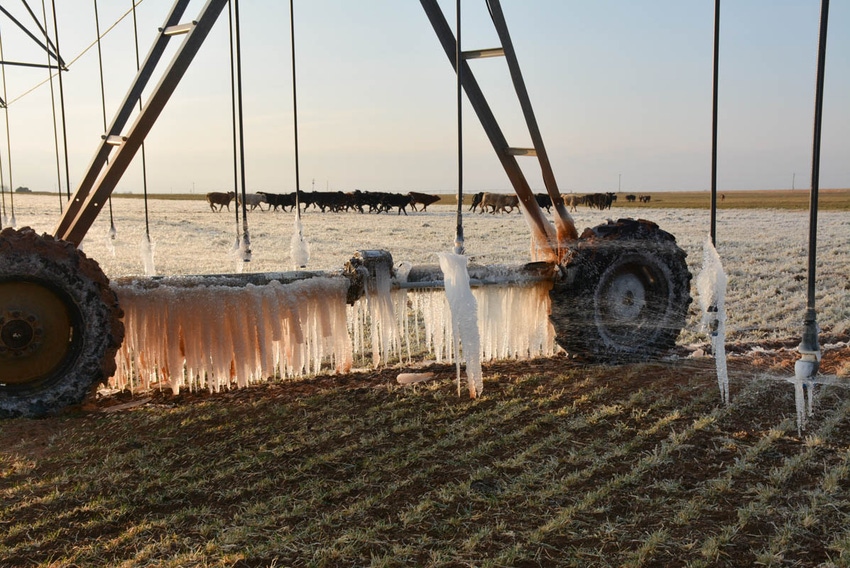
Growers irrigating cover crops or trying to moisten their drought-stricken soil to plow while nighttime temperatures continue to drop below freezing are cautioned to drain their center pivot irrigation systems before the freeze hits to avoid costly ice damage— a claim that is rarely covered by insurance.
“If people are going to be running sprinklers, and truly every manufacturer manual says, ‘Do not run below 34 degrees,’ but if you are going to be running below that, you need to look real close for leaks in and around the tower box controls,” says Daniel Smith, owner of South Plains Irrigation, Olton, Texas. “At 34 degrees with a 10 mph wind the wind chill will drop the temperature below 34 degrees and at that point it starts freezing.”
Since November, Smith’s crew has responded to nearly 50 service calls to repair sprinklers damaged by the ice. Most recently, Smith was called to repair a sprinkler in the Panhandle that resulted in $35,000 worth of uninsured damage.
“Everybody that saw that sprinkler thought that the ice built up on the machine and made it fall but that’s not what happened. The ice actually built up on that tower box and pulled it down,” describes Smith. Further damage resulted from the ice that formed on the top of the machine caused by the water that was continuing to run through and spray on the sprinkler.

Freezing temperatures cause ice buildup on the tower box, pulling the sprinkler down.
If a sprinkler ices up, Smith recommends growers leave the machine alone, allow the ice to melt and then if there’s still an issue, submit a request for a service call. “People often make things worse by trying to fix it themselves. People on the verge of a wreck will call us and rather than leave it they try to fix it before we get there, as was the case with this machine (mentioned above), and make the damage worse.”
This time of year, Smith also cautions growers not to run their sprinklers like they would in the summer. “Be sure to drain the sprinkler at the center pivot point or it will hold water, which can then freeze and split the pipe.”
Another item to check is the auto drain on each tower. “Make sure those are completely drained. They can get clogged and freeze, splitting the pipe. That’s about a $2,000 or $3,000 bill,” he adds.
See photo gallery, Growers cautioned to drain sprinklers prior to freezing temperatures, http://bit.ly/2sn8ZCI.
Spring cleaning
Before producers begin to irrigate for the upcoming season, “spring cleaning,” their machines can save time, money and water, as well as affect the ultimate outcome of their crops. Smith recommends growers make the four following inspections:
No. 1, service the drive train.
“When it’s 20 degrees at night and 60 degrees during the day, condensation often builds up on the inside, which will rust out the bearings,” says Smith. “Producers need to be sure to drain the water and check the oil in the gear box.”
No. 2, and the most important because it affects the sprinkler pressure, is to inspect the splash pads, which diffuse the water, and nozzles that can get worn from sand and air.
“Most critical is running the sprinkler at the correct pressure, especially in a year of drought,” Smith says. “Over pressure is better than being under pressure. You know you are under pressured when there are gaps in the spray pattern; they should be overlapping each other as they spray.”
No. 3, inspect the machine for leaks, something Smith says is easy to spot but will also affect the sprinkler’s pressure if not repaired. “Don’t just let those go,” he says.
“Say you have a #10 nozzle, you know how small those holes are, and at 15 pounds of pressure, it can be leaking up to 3 gallons a minute, so if you get three or four of those, suddenly it’s 15 gallons a minute,” says Smith. “That can be the difference between you being at the right pressure or the wrong pressure. It’s not just about watering; it’s about making sure the sprinkler is at the right pressure.”
No. 4, check the tire pressure on the sprinkler tires.
“The recommended pressure is different on different soil types,” says Smith, who suggests recap or new tires. With sandier soils, he recommends 11.2x24 inch tires, while in heavier, more clay-type soils, he says the 11.2x38 inch tires work best.
No. 5, and lastly, even though some growers may be running their sprinklers now, if they have sat idle for a month or longer, when it comes time to fire them up for the 2018 growing season, Smith recommends re-inspecting them.
For a complete checklist, go to: http://www.zimmatic.com/spring-maintenance.
About the Author(s)
You May Also Like






